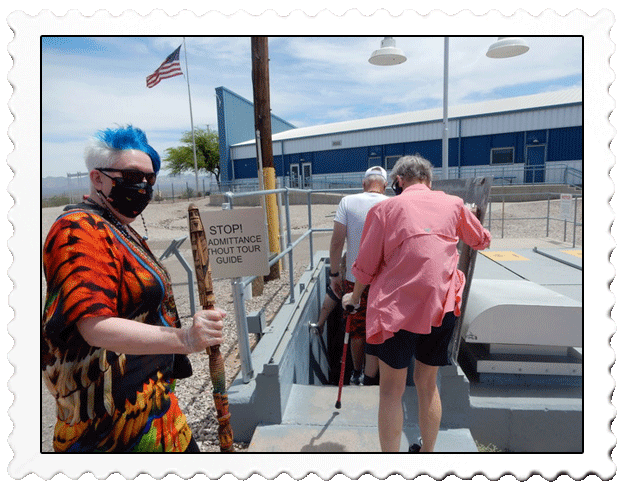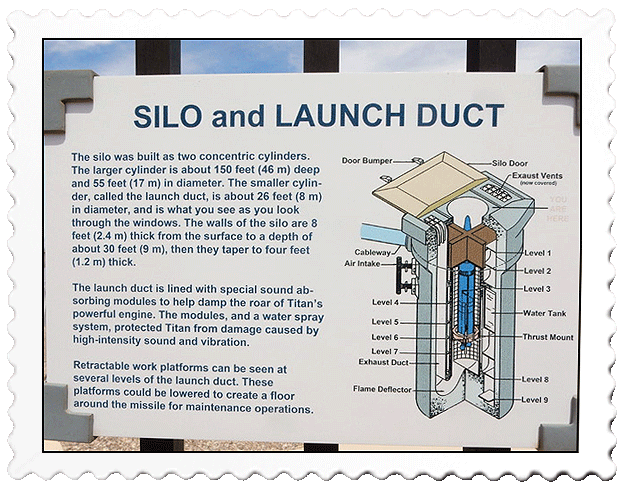By DAVE GJESTSON

The Titan missile system was a strategic United States deterrent against
nuclear war and was coupled with ballistic missile aircraft and ballistic
missile submarines to form a military system known as the Nuclear Triad.
The U.S. Air Force operated the Titan II missile system at three, 18-missile
complexes located near Little Rock, Arkansas, Wichita, Kansas, and
Tucson, Arizona from 1963 to 1987.
The Titan missile was the largest, most powerful weapon ever used by the
United States. Each missile carried a nine megaton nuclear warhead
capable of delivering 300 square miles of devastation to targets 8,700
miles away inside of 35 minutes at speeds up to 16,000 mph! The nuclear
explosion was the equivalent of nine million tons of TNT described as a
train load of TNT stretching from Tucson, Arizona to some place in
Kentucky!
Laura and I couldn’t pass up the chance to visit a Titan II missile site
museum located in Green Valley, Arizona, just 40 minutes from our casa in
Rio Rico. We were joined by our good friends Keith and Janet Sewell
making our reservations well in advance of the tour date. After checking in
at the visitor center and watching a brief introductory film, we followed our
guide to the underground control center.

Laura (in pink shirt) follows the tour guide to the command center entrance (note the missile silo protective cover in the center of the photo)
We were warned in advance to be prepared to negotiate a steep 55-step
stairway to gain access to the command center. Additionally, we were all
required to wear face masks and plastic gloves necessary to avoid
contamination of the sensitive, historic facility.

Going down the steep, 55-step entrance was challenging for old folks! (The colorful lady on the left is our good friend, Janet Sewell.)
As you’d expect, security was crucial during its operational phase. The
three-acre grounds were encircled with fencing and razor wire, patrolled
and under camera watch. Access was through a guard gate and then a
system of four steel doors to access the command center. A telephone by
each door had to be used with a daily changing password within a
prescribed time limit for the door to be opened.
The steel blast-proof doors were immense! Almost a foot thick and
weighing three tons, the massive doors were designed to withstand a blast
from the latest Russian nuclear bomb delivered in the vicinity. The entire
underground tunnel system as well as the missile silo were suspended on
a series of hydraulic pumps that cushioned everything during an
explosion.

Janet examines one of the four blast doors guarding access to the command center
In the command center, we learned that a team of two Air Force officers
and two enlisted men (rotated with other four-man crews) manned it 24-7
for almost 25 years! A two-man rule was in effect at all times, meaning at
no time was anyone allowed solo in the control room. Two floors contains
additional equipment was located below the control room.
When the warning of an attack was received (in code) with orders to
prepare to launch, two officers opened a two-key safe and withdrew
several coded envelopes. Only the coded envelope that was identified in
the order was to be opened with the target identified. Each officer inserted
a launch key and, on signal, both turned the key at the same time. The
launch button was displayed in red in front of each officer. A launch signal
followed.

The command center.The two men are sitting where the two officers on duty monitored the missile and received their orders
We then walked down a long corridor to emerge on the second story of an
eight-story structure enveloping the missile. Here we learned of the
elaborate, daily maintenance schedule to keep the missile ready for
launch. A sophisticated heating/cooling system kept the entire silo
containing the missile at a steady 60 degrees.
While advance warning enabled the missile crew to start liquid fuel to start
flowing into the rocket engine and water/steam to flow to keep
temperatures controlled the missile could be launched in less than one
minute!

The nose cone of the missile carried the nine megaton nuclear warhead


The missile measured 10 feet across and was 103 feet in length!
Leaving the silo, we returned up the 55 steps to the surface again and
walked around the missile shield for a closer look at the silo protective
cover and to get a look at the business end of the missile. We also got a
look at the rocket motor and were surprised to see how small it was. After
the Titan II system was abandoned for more solid fuel missiles in 1987, the
Titan rocket was adapted to propelling the Gemini space program for
many years.

As we left the command center entrance, the guide pointed out the telephone poles and noted that the missile was twice that length!

Looking from the top, we could only see the top half of the missile’s 103 foot length

The rocket motor was surprisingly small (Laura reluctantly agreed to pose for the size perspective!)

















